Last updated
Customize pricing
Learn how to customize pricing in your marketplace by adding an optional cleaning fee on top of the regular nightly price of the accommodation.
Table of Contents
- Store cleaning fee into listing
- Save to public data
- Initialize the form
- Add input component
- Update BookingDatesForm
- Prepare props
- Add cleaning fee checkbox
- Update the orderData
- Add a new line-item for the cleaning fee
- Resolve the cleaning fee
- Add line-item
- Update CheckoutPage to handle cleaning fee
- Fetch speculated transaction complete with cleaning fee
- Include cleaning fee in the final transaction price
- Summary
In this tutorial, you will
- Allow providers to add a cleaning fee to their listings
- Allow customers to select whether they want to include the cleaning fee in their booking
- Include a selected cleaning fee in the transaction's pricing
Information
This tutorial uses the following marketplace configurations:
- Listing types > Transaction process: Calendar booking
Store cleaning fee into listing
Pricing can be based on a lot of variables, and one practical way to build it is to base it on information stored as extended data in listings. In this example, we are using a listing's public data to store information about the cleaning fee.
We will not add new fields to listing configuration in Flex Console, since we do not want to show the cleaning fee in the Details panel. Instead, we start by making some changes to EditListingPricingPanel in EditListingWizard.
└── src
└── containers
└── EditListingPage
└── EditListingWizard
└── EditListingPricingPanel
└── EditListingPricingPanel.jsInformation
If you want to make corresponding changes to listing types with the transaction process Buying and selling products, you'll need to make comparable changes to EditListingPricingAndStockPanel.js instead.
Save to public data
In EditListingPricingPanel, we need to edit the onSubmit function to save the new public data field called cleaningFee. Because we are using FieldCurrencyInput component in this example as the input of choice, the cleaningFee variable will be a Money object when we get it from the submitted values. Money object can't be used directly as public data, so we need to create a JSON object with keys amount and currency, and use it in the underlying API call.
Information
The price attribute is one of the listing's default attributes, so it's passed to Marketplace API directly. The new public data attribute cleaningFee, on the other hand, needs to be under the publicData key.
onSubmit={values => {
const { price, cleaningFee = null } = values;
const updatedValues = {
price,
publicData: {
cleaningFee: { amount: cleaningFee.amount, currency: cleaningFee.currency },
},
};
onSubmit(updatedValues);
}}Initialize the form
Next, we want to pass inital values for price and cleaningFee. For this, we need to get the cleaningFee from listing attributes under the publicData key. Also, because FieldCurrencyInput expects the value to be a Money object, we need to convert the value we get from Marketplace API back to an instance of Money.
const getInitialValues = params => {
const { listing } = params;
const { price, publicData } = listing?.attributes || {};
const cleaningFee = publicData?.cleaningFee || null;
const cleaningFeeAsMoney = cleaningFee
? new Money(cleaningFee.amount, cleaningFee.currency)
: null;
return { price, cleaningFee: cleaningFeeAsMoney };
};Now pass the whole initialValues map in the corresponding prop to
EditListingPricingForm.
Add input component
We want to be able to save the listing's cleaning fee amount, so we add a new FieldCurrencyInput to the EditListingPricingForm. The id and name of this field will be cleaningFee.
Adding this fee will be optional, so we don't want to add any validate param to the FieldCurrencyInput like there is in the price input.
└── src
└── containers
└── EditListingPage
└── EditListingWizard
└── EditListingPricingPanel
└── EditListingPricingForm.js...
<FieldCurrencyInput
id={`${formId}price`}
name="price"
className={css.input}
autoFocus={autoFocus}
label={intl.formatMessage(
{ id: 'EditListingPricingForm.pricePerProduct' },
{ unitType }
)}
placeholder={intl.formatMessage({ id: 'EditListingPricingForm.priceInputPlaceholder' })}
currencyConfig={appSettings.getCurrencyFormatting(marketplaceCurrency)}
validate={priceValidators}
/>
<FieldCurrencyInput
id={`${formId}cleaningFee`}
name="cleaningFee"
className={css.input}
autoFocus={autoFocus}
label={intl.formatMessage(
{ id: 'EditListingPricingForm.cleaningFee' },
{ unitType }
)}
placeholder={intl.formatMessage({ id: 'EditListingPricingForm.cleaningFeePlaceholder' })}
currencyConfig={appSettings.getCurrencyFormatting(marketplaceCurrency)}
/>
...You can use the following microcopy keys:
"EditListingPricingForm.cleaningFee":"Cleaning fee (optional)",
"EditListingPricingForm.cleaningFeePlaceholder": "Add a cleaning fee..."After adding the new microcopy keys, the EditListingPricingPanel should
look something like this:
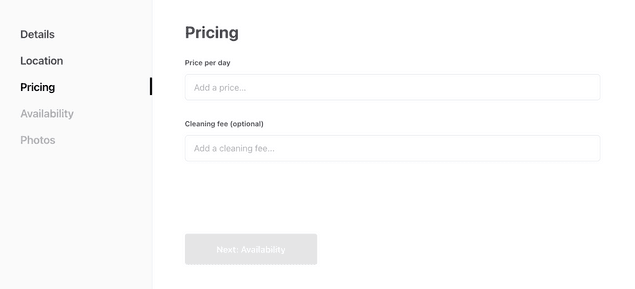
Update BookingDatesForm
In our example the cleaning fee is optional, and users can select it as an add-on to their booking. In this section, we will add the UI component for selecting the cleaning fee and pass the information about the user's choice to the the backend of our client app.
In case you want to add the cleaning fee automatically to every booking, you don't need to add the UI component for selecting the cleaning fee, and you can move forward to the next section: Add a new line item for the cleaning fee.
Information
If you want to make corresponding changes to listing types with the transaction process Buying and selling products, you'll need to make comparable changes to ProductOrderForm instead of BookingDatesForm.
Prepare props
To use the information about cleaning fee inside the BookingDatesForm, we need to pass some new information from OrderPanel to the form. OrderPanel is the component used on ListingPage and TransactionPage to show the order breakdown.
└── src
└── components
└── OrderPanel
└── OrderPanel.jsOrderPanel gets listing as a prop. The cleaning fee is now saved in the listing's public data, so we can find it under the publicData key in the listing's attributes.
Because adding a cleaning fee to a listing is optional, we need to check whether or not the cleaningFee exists in public data.
const cleaningFee = listing?.attributes?.publicData.cleaningFee;Once we have saved the cleaning fee information to the variable cleaningFee, we need to pass it forward to BookingDatesForm. This form is used for collecting the order data (e.g. booking dates), and values from this form will be used when creating the transaction line items. We will pass the cleaningFee to this form as a new prop.
<BookingDatesForm
className={css.bookingForm}
formId="OrderPanelBookingDatesForm"
lineItemUnitType={lineItemUnitType}
onSubmit={onSubmit}
price={price}
marketplaceCurrency={marketplaceCurrency}
dayCountAvailableForBooking={dayCountAvailableForBooking}
listingId={listing.id}
isOwnListing={isOwnListing}
monthlyTimeSlots={monthlyTimeSlots}
onFetchTimeSlots={onFetchTimeSlots}
timeZone={timeZone}
marketplaceName={marketplaceName}
onFetchTransactionLineItems={onFetchTransactionLineItems}
lineItems={lineItems}
fetchLineItemsInProgress={fetchLineItemsInProgress}
fetchLineItemsError={fetchLineItemsError}
+ cleaningFee={cleaningFee}
/>Add cleaning fee checkbox
Next, we need to add a new field to BookingDatesForm for selecting the possible cleaning fee. For this, we will use the FieldCheckbox component, because we want the cleaning fee to be optional.
└── src
└── components
└── OrderPanel
└── BookingDatesForm
└── BookingDatesForm.js
└── BookingDatesForm.module.cssIn BookingDatesForm we need to import a couple of new resources we need to add the cleaning fee. These will include a few helper functions necessary to handle the cleaningFee price information, as well as the checkbox component FieldCheckbox.
import { propTypes } from '../../util/types';
+ import { formatMoney } from '../../../util/currency';
+ import { types as sdkTypes } from '../../../util/sdkLoader';
...
import {
Form,
IconArrowHead,
PrimaryButton,
FieldDateRangeInput,
H6,
+ FieldCheckbox,
} from '../../../components';
import EstimatedCustomerBreakdownMaybe from './EstimatedCustomerBreakdownMaybe';
import css from './BookingDatesForm.module.css';
+ const { Money } = sdkTypes;When we have imported these files, we will add the checkbox component for selecting the cleaning fee. For this, we need to extract the cleaningFee from fieldRenderProps.
...
lineItems,
fetchLineItemsError,
onFetchTimeSlots,
+ cleaningFee,
} = fieldRenderProps;We want to show the amount of cleaning fee to the user in the checkbox label, so we need to format cleaningFee to a printable form. For this, we want to use the formatMoney function that uses localized formatting. This function expects a Money object as a parameter, so we need to do the conversion.
const formattedCleaningFee = cleaningFee
? formatMoney(
intl,
new Money(cleaningFee.amount, cleaningFee.currency)
)
: null;
const cleaningFeeLabel = intl.formatMessage(
{ id: 'BookingDatesForm.cleaningFeeLabel' },
{ fee: formattedCleaningFee }
);We will also add a new microcopy key BookingDatesForm.cleaningFeeLabel to the en.json file, and we can use the fee variable to show the price.
"BookingDatesForm.cleaningFeeLabel": "Cleaning fee: {fee}",Because there might be listings without a cleaning fee, we want to show the checkbox only when needed. This is why we will create the cleaningFeeMaybe component which is rendered only if the listing has a cleaning fee saved in its public data.
const cleaningFeeMaybe = cleaningFee ? (
<FieldCheckbox
className={css.cleaningFeeContainer}
id={`${formId}.cleaningFee`}
name="cleaningFee"
label={cleaningFeeLabel}
value="cleaningFee"
/>
) : null;Then we can add the cleaningFeeMaybe to the returned <Form>
component
...
isDayBlocked={isDayBlocked}
isOutsideRange={isOutsideRange}
isBlockedBetween={isBlockedBetween(monthlyTimeSlots, timeZone)}
disabled={fetchLineItemsInProgress}
onClose={event =>
setCurrentMonth(getStartOf(event?.startDate ?? startOfToday, 'month', timeZone))
}
/>
+ {cleaningFeeMaybe}
{showEstimatedBreakdown ? (
<div className={css.priceBreakdownContainer}>
<h3>
...As the final step for adding the checkbox, add the corresponding CSS class to BookingDatesForm.module.css.
.cleaningFeeContainer {
margin-top: 24px;
}After this step, the BookingDatesForm should look like this. Note that the cleaning fee will not be visible in the order breakdown yet, even though we added the new checkbox.
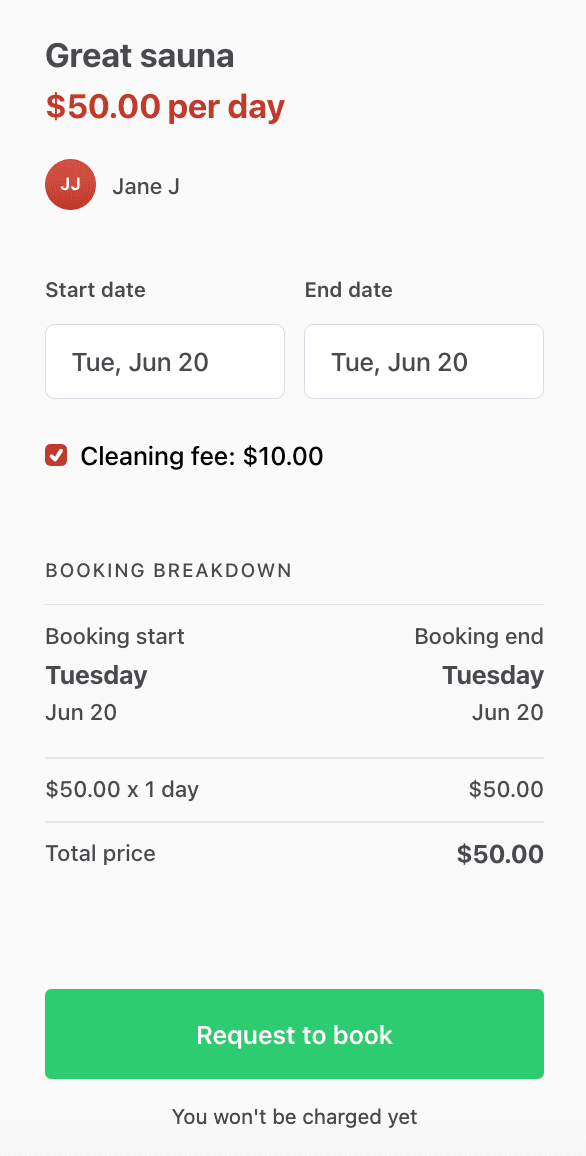
Update the orderData
Next, we want to pass the value of the cleaning fee checkbox as part of the orderData. This is needed so that we can show the selected cleaning fee as a new row in the order breakdown. To achieve this, we need to edit the handleOnChange function, which takes the values from the form and calls the onFetchTransactionLineItems function for constructing the transaction line items. These line items are then shown inside the bookingInfoMaybe component under the form fields.
Information
In Flex, the total price of a transaction is defined by its line items. Line items describe what is included in a transaction. Line items can be varied, from the number of booked units to customer and provider commissions, add-ons, discounts, or payment refunds.
Every line item has a unit price and one of the following attributes: quantity or percentage. The quantity attribute can be used to denote the number of booked units, like the number of booked nights. Quantity can also be defined as a multiplication of units and seats. The percentage param is used, for instance, when modeling commissions. Based on these attributes, a line total is calculated for each line item. Line totals then define the total payin and payout sums of the transaction.
You can read more about line items and pricing in the pricing concepts article.
In the orderData object, we have all the information about the user's choices. In this case, this includes booking dates, and whether or not they selected the cleaning fee.
We only need to know if the cleaning fee was selected. We will fetch the cleaning fee details from Marketplace API later in the the backend of our client app to make sure this information cannot be manipulated.
In our case, because there is just one checkbox, it's enough to check the length of that array to determine if any items are selected. If the length of the cleaningFee array inside values is bigger than 0, the hasCleaningFee param is true, and otherwise it is false. If we had more than one item in the checkbox group, we should check which items were selected.
const handleFormSpyChange = (
listingId,
isOwnListing,
fetchLineItemsInProgress,
onFetchTransactionLineItems
) => formValues => {
const { startDate, endDate } =
formValues.values && formValues.values.bookingDates
? formValues.values.bookingDates
: {};
const hasCleaningFee = formValues.values?.cleaningFee?.length > 0;
if (startDate && endDate && !fetchLineItemsInProgress) {
onFetchTransactionLineItems({
orderData: {
bookingStart: startDate,
bookingEnd: endDate,
hasCleaningFee,
},
listingId,
isOwnListing,
});
}
};Add a new line-item for the cleaning fee
We are making progress! Next, we need to edit the the backend of our client app, and add a new line item for the cleaning fee, so that it can be included in pricing.
Flex uses privileged transitions to ensure that the pricing logic is handled in a secure environment. This means that constructing line items and transitioning requests of privileged transitions are made server-side.
Information
Privileged transitions are transaction process transitions that can only be invoked from a secure context. For example, when using Sharetribe Web Template, this secure context is the backend of the template app. You can also build your own server-side validation that sits between your marketplace UI and the Flex Marketplace API to invoke privileged transitions.
We are using privileged transitions and the backend of our client app to construct line items, because we want to make sure it is done in a secure context. If the client-side code (template front-end) could freely construct the line items, we couldn't fully trust that the price calculation follows the model intended in the marketplace.
In theory, a marketplace user could make a direct API call to the Flex Marketplace API and start a transaction with modified line items – for instance, change the cleaning fee amount. We can avoid this security risk by using privileged transitions and fetching the pricing information, like the cleaning fee amount, directly from Marketplace API in the backend of our client app.
You can read more about privileged transitions in the privileged transitions concepts article.
Since we want to add a new line item for the cleaning fee, we'll need to update the pricing logic in the lineItems.js file:
└── server
└── api-util
├── lineItems.js
└── lineItemHelpers.jsResolve the cleaning fee
First, we will add a new helper function for resolving the cleaning fee line item. This function will take the listing as a parameter, and then get the cleaning fee from its public data. To make sure the data cannot be manipulated, we don't pass it directly from the template frontend. Instead, we fetch the listing from Marketplace API, and check that listing's public data for the accurate cleaning fee.
If you have several helper functions, you might want to add this
function to the lineItemHelpers.js file instead.
const resolveCleaningFeePrice = listing => {
const publicData = listing.attributes.publicData;
const cleaningFee = publicData && publicData.cleaningFee;
const { amount, currency } = cleaningFee;
if (amount && currency) {
return new Money(amount, currency);
}
return null;
};Add line-item
Now the transactionLineItems function can be updated to also provide the cleaning fee line item when the listing has a cleaning fee.
In this example, the provider commission is calculated from the total of booking and cleaning fees. That's why we need to add the cleaningFee item also to calculateTotalFromLineItems(...) function in the providerCommission line item. If we don't add the cleaning fee, the provider commission calculation is only based on the booking fee.
Also remember to add the cleaning fee to the lineItems array that is returned in the end of the function.
exports.transactionLineItems = (listing, orderData) => {
...
const order = {
code,
unitPrice,
quantity,
includeFor: ['customer', 'provider'],
};
+ const cleaningFeePrice = orderData.hasCleaningFee ? resolveCleaningFeePrice(listing) : null;
+ const cleaningFee = cleaningFeePrice
+ ? [
+ {
+ code: 'line-item/cleaning-fee',
+ unitPrice: cleaningFeePrice,
+ quantity: 1,
+ includeFor: ['customer', 'provider'],
+ },
+ ]
+ : [];
+
// Provider commission reduces the amount of money that is paid out to provider.
// Therefore, the provider commission line-item should have negative effect to the payout total.
const getNegation = percentage => {
return -1 * percentage;
};
// Note: extraLineItems for product selling (aka shipping fee)
// is not included to commission calculation.
const providerCommissionMaybe = hasCommissionPercentage(providerCommission)
? [
{
code: 'line-item/provider-commission',
- unitPrice: calculateTotalFromLineItems([order]),
+ unitPrice: calculateTotalFromLineItems([order, ...cleaningFee]),
percentage: getNegation(providerCommission.percentage),
includeFor: ['provider'],
},
]
: [];
// Let's keep the base price (order) as first line item and provider's commission as last one.
// Note: the order matters only if OrderBreakdown component doesn't recognize line-item.
- const lineItems = [order, ...extraLineItems, ...providerCommissionMaybe];
+ const lineItems = [order, ...extraLineItems, ...cleaningFee, ...providerCommissionMaybe];
return lineItems;
};Once we have made the changes to the backend of our client app, we can check the order breakdown again. If you now choose the cleaning fee, you should see the cleaning fee in the booking breakdown:
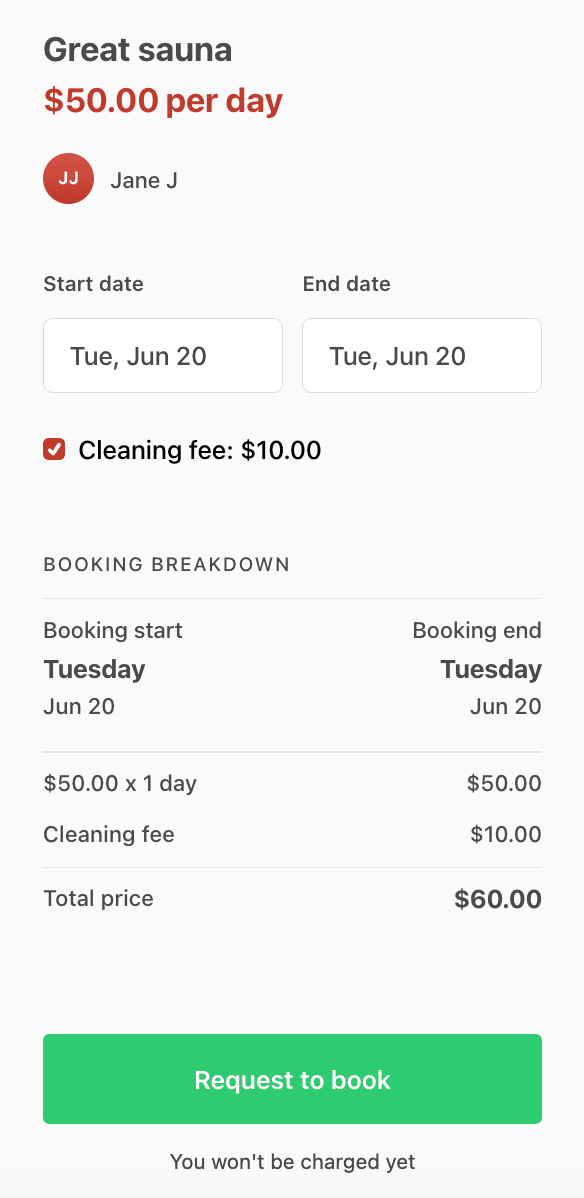
Update CheckoutPage to handle cleaning fee
Finally, we want to update the Checkout Page so that it takes the cleaning fee selection into account when the customer actually pays for the booking.
Fetch speculated transaction complete with cleaning fee
When a user clicks "Request to book", ListingPage.js sends the booking
details as initial values to CheckoutPage.js, which then fetches the
possible transaction information, including pricing, to be shown on the
checkout page. In Flex language, this is known as "speculating" the
transaction - the booking has not been made, but the line items are
calculated as if it were.
This means that we need to first pass the cleaning fee information to
the function that speculatively fetches the transaction in
CheckoutPage.js, and then receive it in CheckoutPage.duck.js. First,
the CheckoutPage.js loadInitialData() does some data processing and,
if necessary, calls fetchSpeculatedTransaction().
└── src
└── containers
└── CheckoutPage
└── CheckoutPage.jsloadInitialData() {
...
const deliveryMethod = pageData.orderData?.deliveryMethod;
+ const hasCleaningFee = pageData.orderData?.cleaningFee?.length > 0;
fetchSpeculatedTransaction(
{
listingId,
deliveryMethod,
+ hasCleaningFee,
...quantityMaybe,
...bookingDatesMaybe(pageData.orderData.bookingDates),
},
processAlias,
transactionId,
requestTransition,
isPrivileged
);
...This function call dispatches a speculateTransaction action in
CheckoutPage.duck.js, which in turn calls the template server using
the correct endpoint.
└── src
└── containers
└── CheckoutPage
└── CheckoutPage.duck.jsTo pass the cleaning fee selection to the API call, we add it to
orderData within the speculateTransaction action.
export const speculateTransaction = (
...
- const { deliveryMethod, quantity, bookingDates, ...otherOrderParams } = orderParams;
+ const { deliveryMethod, quantity, bookingDates, hasCleaningFee, ...otherOrderParams } = orderParams;
...
// Parameters only for client app's server
- const orderData = deliveryMethod ? { deliveryMethod } : {};
+ const orderData = deliveryMethod || hasCleaningFee ? { deliveryMethod, hasCleaningFee } : {};
Now when the customer selects cleaning fee on the listing page and clicks "Request to book", we see the correct price and breakdown on the checkout page.
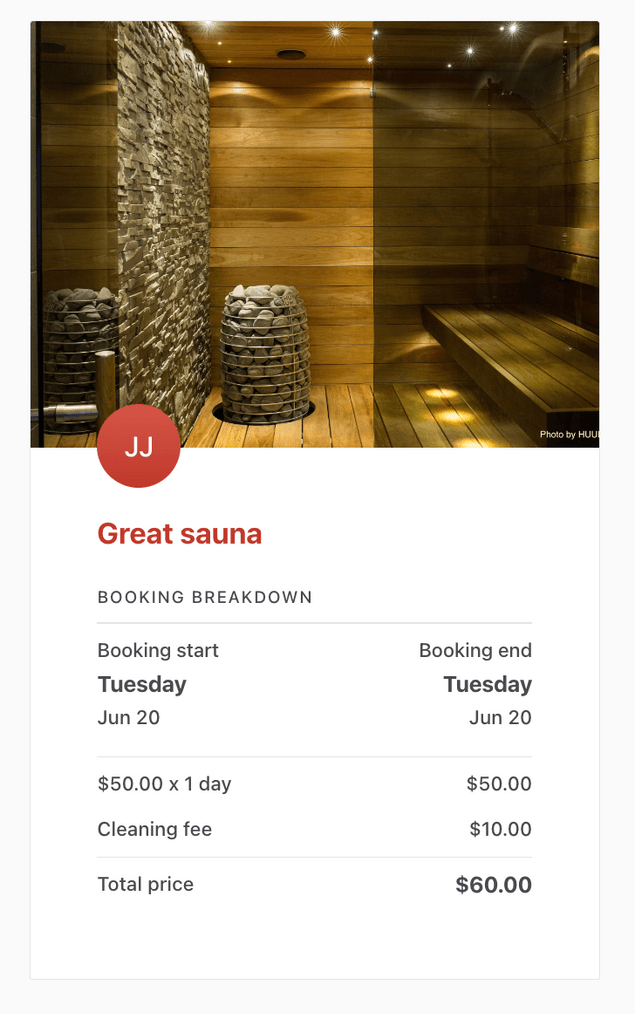
Include cleaning fee in the final transaction price
The final step is to add the same logic to the flow that eventually sets the price for the transaction.
└── src
└── containers
└── CheckoutPage
└── CheckoutPage.jsIn CheckoutPage.js, the function that does the heavy lifting in
handling the payment processing is handlePaymentIntent(). In short, it
first creates five functions to handle the transaction payment process,
then composes them into a single function
handlePaymentIntentCreation(), and then calls that function with
parameter orderParams.
To add the cleaning fee information into this process, we want to
include it in orderParams, which is defined towards the very end of
handlePaymentIntent() function.
const deliveryMethod = pageData.orderData?.deliveryMethod;
+ const hasCleaningFee = pageData.orderData?.cleaningFee?.length > 0;
...
const orderParams = {
listingId: pageData.listing.id,
deliveryMethod,
+ hasCleaningFee,
...quantityMaybe,
...bookingDatesMaybe(pageData.orderData.bookingDates),
...protectedDataMaybe,
...optionalPaymentParams,
};Then, we still need to add the cleaning fee information to the correct
action in CheckoutPage.duck.js.
└── src
└── containers
└── CheckoutPage
└── CheckoutPage.duck.jsThe first function in the handlePaymentIntentCreation() composition is
fnRequestPayment. It initiates the order if there is no existing
paymentIntent, and in practice it dispatches the initiateOrder action
that calls the template server. So similarly to the
speculateTransaction action, we just need to add the cleaning fee
selection to orderData in initiateOrder.
export const initiateOrder = (
...
- const { deliveryMethod, quantity, bookingDates, ...otherOrderParams } = orderParams;
+ const { deliveryMethod, quantity, bookingDates, hasCleaningFee, ...otherOrderParams } = orderParams;
...
// Parameters only for client app's server
- const orderData = deliveryMethod ? { deliveryMethod } : {};
+ const orderData = deliveryMethod || hasCleaningFee ? { deliveryMethod, hasCleaningFee } : {};
Now you can try it out! You may have to refresh your application first, so that the Redux changes take effect. When you complete a booking on a listing that has a cleaning fee specified, you can see the cleaning fee included in the price on the booking page. In addition, the Flex Console transaction price breakdown also shows the cleaning fee.
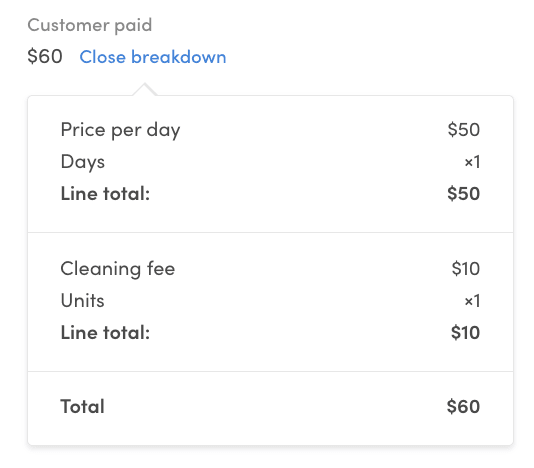
{{#each tx-line-items}}
{{#contains include-for "provider"}}
{{#eq "line-item/day" code}} ...
+ {{#eq "line-item/cleaning-fee" code}}
+ <tr class="bottom-row">
+ <td>Cleaning fee</td>
+ <td class="right">{{> format-money money=line-total}}</td>
+ </tr>
+ {{/eq}}
{{#eq "line-item/provider-commission" code}} ...
{{/contains}}
{{/each}}The email templates that list the full line items in the default booking process are
new-booking-request(to provider)booking-request-accepted(to customer)money-paid(to provider)
Summary
In this tutorial, you have
- Saved a cleaning fee attribute to the listing's public data in EditListingPricingPanel
- Updated the BookingDatesForm and OrderPanel to show and handle cleaning fee selection
- Added cleaning fee to line item handling server-side
- Updated the CheckoutPage to include cleaning fee in the booking's pricing